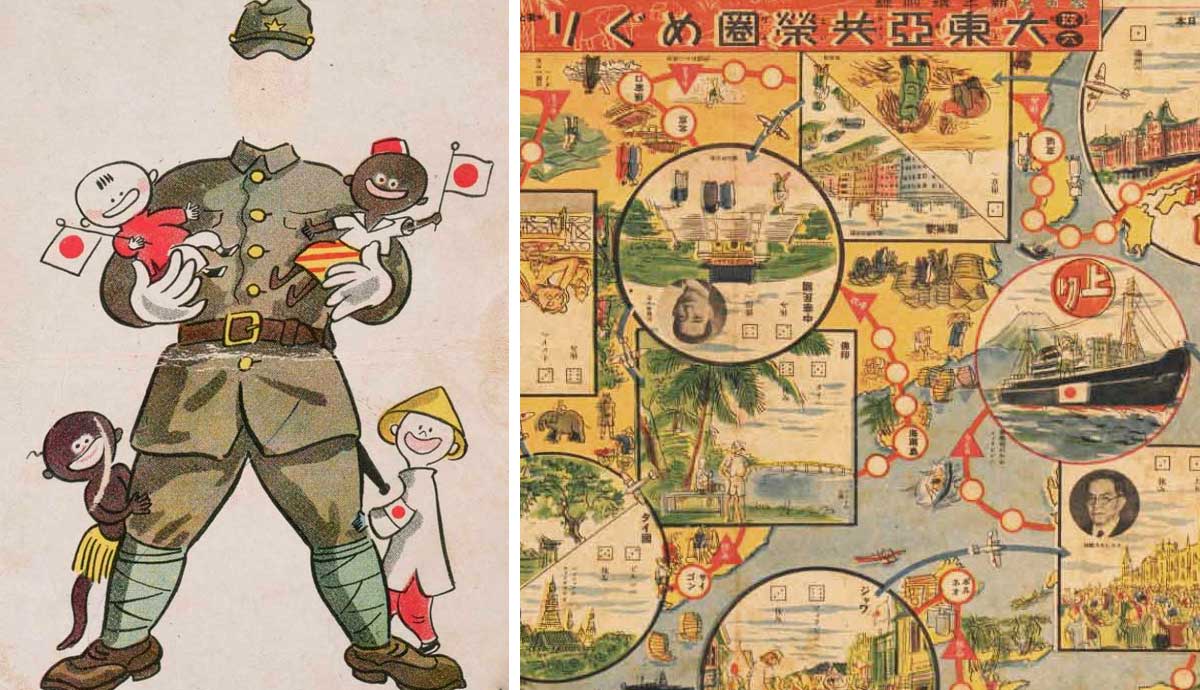
Marred by repression and widespread poverty and starvation, the Japanese Occupation in the 1940s brought about unspeakable suffering and socioeconomic problems in several Asian states. At its height in the early 1940s, Japanese imperial rule stretched across most of Southeast Asia, including modern-day Singapore, Malaysia, Indonesia, Myanmar, the Philippines, Vietnam, Laos, and Cambodia. Prior to that, in the 1930s, China had fallen to Japanese incursions, sparking the Second Sino-Japanese War (1937–1945). As part of the general Pacific campaign, Hong Kong was also occupied by the Japanese in December 1941. Igniting the nationalistic sentiments of those who lived to tell the stories of horrors and hopelessness, the Occupation would later pave the way for unprecedented socio-political changes.
1. The Greater East Asia Co-Prosperity Sphere Was Propagated

Officially announced in August 1940 by the Japanese Foreign Minister Yōsuke Matsuoka, the Greater East Asia Co-Prosperity Sphere sold the idea of Asia for Asiatics. In other words, Japan was trying to convince its subjects in occupied territories that Japanese rule would bring about peace and prosperity. This also marked the Japanese determination to triumph over the western imperial powers who had ruled Southeast Asia since the 16th century.
The Dutch and the French had colonized Indonesia and Indochina (modern-day Laos, Vietnam, and Cambodia) respectively. In Malaya (modern-day Malaysia and Singapore) and Burma (modern-day Myanmar), the British Empire had established a solid political and economic foothold. The Philippines was first colonized by the Spanish in 1565 and later ceded to the United States in 1898. Fundamentally, the Greater East Asia Co-Prosperity Sphere aimed to send the message that Asia would be freed from all external influences and prosper under the guidance and leadership of Japan. In reality, it was a fallacious promise, a means to justify Japan extracting key resources from the occupied territories to fuel its war machine.
2. Economic Hardship Was a Reality in the Occupied Territories

Despite the promise of economic prosperity under the Greater East Asian Co-Prosperity Sphere, there was widespread poverty and chronic food shortage in the occupied territories. Under Japanese rule, trade and export production were badly impacted. In Indonesia, rubber production, which was a key export commodity, fell to one-fifth of the pre-war level. In Malaya, the export of rubber and tin came to a sudden halt during the Japanese Occupation.
The everyday people suffered immensely from the scarcity of necessities and medical supplies. Due to the scarcity, the Japanese instituted a rationing system in which every registered household would receive ration cards. This would allow them to purchase food and other essentials at controlled prices. However, frequent long queues at rationing stations, as well as items of poor quality and declining quantity resulted in widespread starvation. This also fuelled the growing black markets which were strictly forbidden and any association with them could lead to unwanted trouble with the Japanese authorities.

While hunger and poverty were commonplace during the Occupation years, the situation differed with each occupied territory. One of the worst instances was the Great Vietnamese Famine from October 1944 to May 1945. Owing to a combination of factors including French and Japanese mismanagement, Allied bombings, and natural disasters, the famine killed between 600,000 to 2 million Vietnamese.
3. There Was Intense Propaganda

Japanese wartime propaganda was disseminated through films, music, print media, as well as the education system. With a heavy emphasis on nationalism, it focused on promoting Japanese superiority, as opposed to the exploitation and decadence of the western imperial powers. For example, the Japanese propaganda ministry created the film The Opium War (1943) to remind the Chinese people of the humiliation they had endured during the First Opium War in the 19th century. Not only was the film created to stoke anti-British sentiments, but it was also Japan’s way of implying that by invading China, the Japanese were the saviors of the Chinese people.

Magazines and newspapers in occupied territories, regularly featured favorable reports on the Japanese war effort, militaristic slogans, and articles promoting anti-western sentiments. The people, adults and children alike, were also made to learn Japanese, as it was seen as a way to inculcate the Nippon Spirit. Clocks and calendars, too, were adjusted to follow the Tokyo standard.
4. The Oppressive Kempeitai Used Brutal Methods

Known as the Japanese’s version of the Gestapo, the Kempeitai were the secret police infamous for their ruthlessness and intolerance of opposition. They were permitted to make indiscriminate arrests and were often brutal in the way they interrogated those arrested. Confessions, oftentimes false, were obtained through torture methods such as whipping, flogging, physical boiling, and even the tearing out of fingernails. It was no surprise that a few of these internees made it out alive eventually. With arbitrary powers to intimidate, arrest, and imprison the people, the Kempeitai could conduct large-scale operations to weed out any opposition in the population. Many of these operations, however, were poorly planned and resulted in the wrongful arrests and deaths of innocent civilians in the occupied territories.
5. The Horrific Rape of Nanking Happened

In China, over a period of six weeks in late 1937, the Japanese brutally murdered hundreds of thousands of Chinese in the city of Nanking. Known also as the Rape of Nanking, the horrifying atrocities committed also included pillages, rape of women and young girls, looting, and arson among others. The findings at the Tokyo Trial in 1946 estimated at least 200,000 murders and 20,000 rape cases.
With deep-seated animosity towards the Chinese as a result of the Sino-Japanese Wars, the Japanese were determined to weed out any hint of Chinese-led opposition. In the name of purging anti-Japanese elements, the Kempeitai committed mass killings, torture, and rape mostly targeted at the Chinese community in some occupied territories. In Singapore, tens of thousands of male Chinese aged 18 to 50 were rounded up and sent to killing sites between February and March 1942. This operation came to be known as Sook Ching or “purge through cleansing”, in which over 50,000 people were estimated to have died. Throughout the Occupation, mass killings involving civilians and servicemen occurred, including the St. Stephen’s College massacre (December 1941), the Changjiao massacre (May 1943), and the Manila Massacre (February to March 1945).
6. The Japanese Soldiers Were Infamous for Sexual Slavery

Beyond the horrifying mass rapes in Nanking, the Imperial Japanese Army had set up military brothels and comfort stations in occupied territories throughout the war. Girls and women from all over Southeast Asia, China, and Korea were often lured, coerced, or duped into providing sexual services for the Japanese army. Known as comfort women, they were the military sex slaves forced to service the Japanese soldiers under inhumane conditions. While the exact number of women involved remains to be debated, historians’ estimation ranges between 50,000 to 200,000.
Wounded, ravaged, and humiliated, these women later suffered from sterility and venereal diseases, on top of the psychological trauma and discrimination they had to endure. To this day, the issue of wartime sexual slavery remains controversial and divisive. While some survivors have been campaigning for their side of history to be heard, others lived with the traumatic memory and died waiting for a closure that never came.
7. The Imperial Japanese Army Allegedly Practised Cannibalism

Perhaps one of the grisliest findings to emerge years after the war was the incidence of cannibalism by the Japanese army. In 1992, historian Toshiyuki Tanaka revealed in his research over 100 cases of cannibalism committed by Japanese troops in Papua New Guinea during World War II. Historical documents and survivor testimonies exposed how the soldiers consumed the flesh of Australian soldiers, Asians, as well as the indigenous population. Sometimes the deed was done out of hunger and desperation, other times, it was motivated by a chilling psychological desire to conquer the enemy. Another notable account involved the Suzuki Unit in the Philippines, where human bones and flesh were discovered within its camp premises in 1945. It was later revealed in a trial that the unit had frequently consumed human flesh by capturing and butchering local Filipinos during World War II.
8. The Japanese Conducted Human Experiments and Created Biochemical Weapons

Under the guise of an Epidemic Prevention and Water Purification Department, the Imperial Japanese Army conducted unethical human experimentation on POWs in China. The notorious Unit 731, based in Harbin, China, was responsible for hundreds of thousands of deaths from disease injections, vivisections, weapons testing, and amputation, among others. Unit 731 and its affiliated units were also tasked to research and create biochemical weapons targeted at the Chinese populace as part of the Second Sino-Japanese War. Plague-infected fleas were cultivated and later dropped on Chinese cities such as Ningbo and Changde in the early 1940s. As inconspicuous as it could be, Japan’s network of biological warfare development units stretched across Asia during World War II. They were present in Singapore, Guangzhou, and Beijing, and were rumored to have existed in Burma and Thailand as well.
9. Prisoners-of-War Were Subjected to Torture and Abuse

An explicit violation of the 1907 Fourth Hague Convention, the Japanese subjected prisoners-of-war (POWs) in the occupied territories to torture and forced labor. Post-war tribunal findings revealed that over 350,000 POWs were interned under Japanese rule and a good 27% died in captivity. Many of the POWs were forced to work on construction projects under inhumane conditions, with the most infamous of all being the Death Railway. From 1940 to 1943, over 60,000 Allied POWs along with at least 180,000 Southeast Asian civilians were made to build the Thai-Burma Railway. Subjected to malnutrition, physical abuse, and tropical diseases among others, it was estimated that over 100,000 laborers lost their lives in the process.

Forced marches were also common during the Occupation. In April 1942, some 76,000 POWs consisting of 66,000 native Filipinos were forced to walk over 65 miles to a prison camp. Under intense heat, the POWs were subjected to disease, starvation, and sporadic killings by the Japanese. Some 20,000 POWs died during the march and never made it to the destination. This came to be known as the Bataan Death March. In the closing months of the war in 1945, over 2,400 Allied POWs succumbed to sickness, starvation, and brutal treatment in a series of forced marches in Borneo.
10. Anti-Japanese Resistance Groups Were Active Throughout the Occupation

Despite the propaganda efforts by the Japanese, the locals in occupied territories were generally not convinced of the long-term feasibility of Japanese rule. While many found ways to survive under the oppressive Japanese rule, others banded together to resist the Japanese and their collaborators. Some of these resistance movements worked with or under the Allied powers to liberate their homelands from Japanese control. Their activities included intelligence gathering, sabotaging Japanese activities, guerrilla warfare, and propaganda.
Notable units included the Hunters ROTC in the Philippines, Force 136 in Malaya, and Dalforce in Singapore. Underground resistance groups gained not only local support but also the confidence and experience that would aid them in the post-war struggle for independence. With Allied counter-offensive strategies, along with depleting resources in the overstretched Japanese empire, the tide of the Pacific War began to turn by 1943. The ultimate event leading to the Japanese surrender would come in August 1945 with the dropping of atomic bombs on Hiroshima and Nagasaki.










